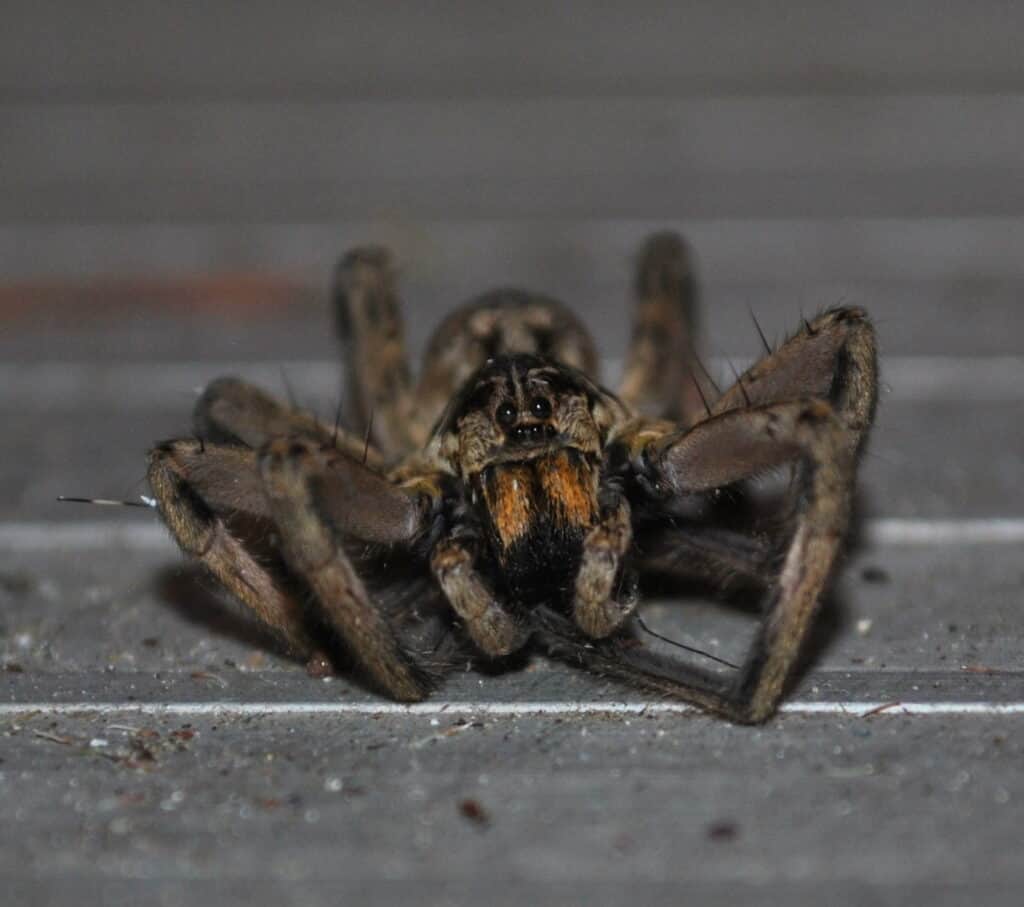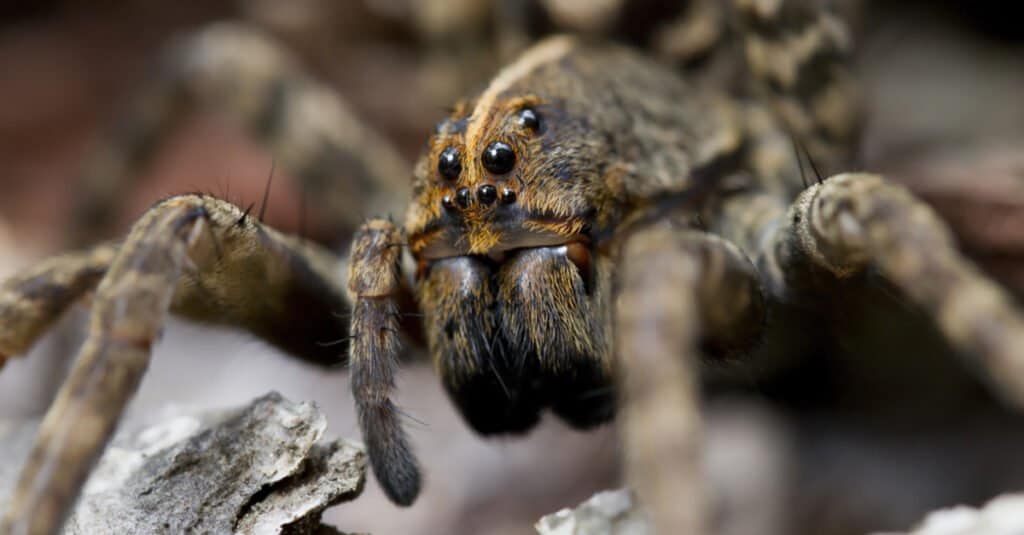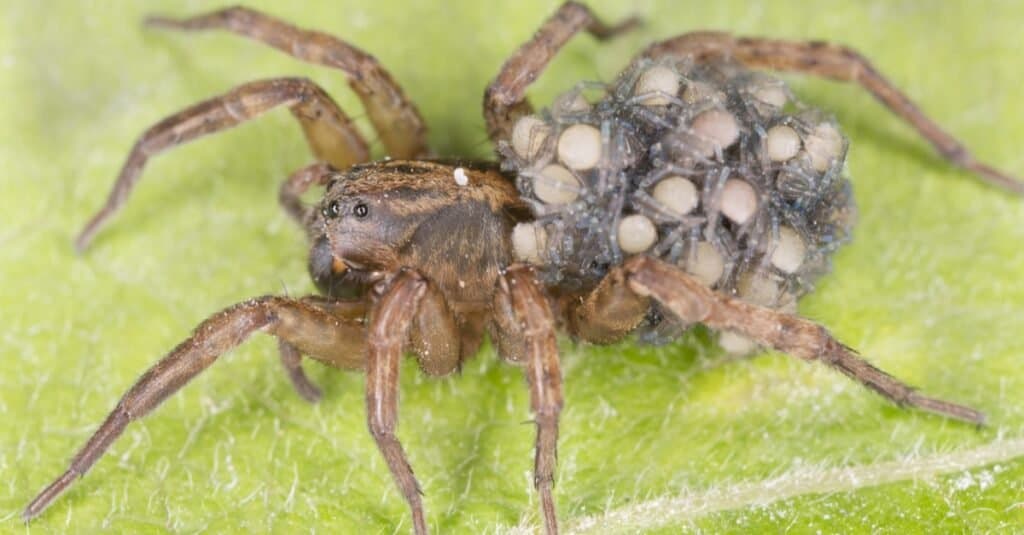What’s the best thing about Colorado? Depending on who you are, that could be hard to decide! Many people would say the awesome skiing is the highlight of this gorgeous American state; others might cite its breathtaking canyons and forests. Virtually no one would say they go to Colorado for the wolf spiders. Unfortunately, these hairy arachnids are common, occupying both rural and urban locations. Read on to find out everything you need to know about wolf spiders in Colorado, from how to identify them to how to live with them!

There are over 2,800 species of wolf spiders; at least 5 of these species inhabit Colorado.
©Aaron Carlson / CC BY-SA 2.0, Flickr – License
What is a Wolf Spider?
Wolf spiders are midsized spiders within the family Lycosidae. Though there are over 2,800 species of wolf spiders in 124 genera, most of them bear a close resemblance to one another and may be difficult to tell apart. Among the 28 species of spiders in Colorado, at least 5 belong to the wolf spider family, including:
- Carolina wolf spider (Hogna carolinensis)
- Tigrosa grandis
- Schizocosa mccooki
- Geolycosa missouriensis
- Hogna frondicola
Where does the name “wolf spider” come from, anyway? Is it as terrifying as it sounds? Unfortunately, yes! The name Lycosidae means “wolf” in Greek, signifying both the spiders’ physical appearance and their hunting behaviour. With their hairy grey bodies, they appear wolflike to observers. Worse yet, they don’t weave webs to capture prey like the majority of spider species on the planet. They don’t need to! With incredible speed and agility, wolf spiders run down their prey much as an actual wolf would, injecting their victims with venom upon capture.
How to Identify Colorado Wolf Spiders
As already mentioned, most wolf spiders in Colorado look similar to one other and to other species across the world. Their thick bodies and long legs give them an intimidating appearance with abundant body hair. Possible colours include black, brown, or grey. Some species bear tan or light orange markings.
Of course, the most terrifying part of a spider is its head and mouth. The wolf spider’s eight bulging eyes can be particularly unsettling. These eyes occur in three rows: two small ones high on the head, two large main eyes in the centre of the face, and four small eyes just above the mouth. Because of their numerous eyes, wolf spiders have excellent vision. To make matters worse, their mouth appendages are large and powerful.
How Big Do Colorado Wolf Spiders Get?

The largest wolf spider is the Carolina wolf spider with a body length of up to 1.4 inches.
©Will E. Davis/Shutterstock.com
By now, you might be envisioning a spider of Herculean proportions. However, this isn’t the case! Wolf spiders are generally not very big despite their fearsome appearance. The Carolina wolf spider is the largest species in the Lycosidae family with a typical body length of 1.2 inches (3 centimetres). However, some remarkable individuals have reached 1.4 inches (3.5 centimetres) in length, not including the legs. The smallest members of the wolf spider family measure no more than 0.24 inches (0.6 centimetres). Spiders commonly exhibit sexual dimorphism, with females being significantly larger than males. This is also true for wolf spiders.
Where Are Colorado Wolf Spiders Found?
Wolf spiders are common throughout the state of Colorado. However, they are especially numerous in the Front Range, a range of mountains running through central Colorado. Though careful observers may find them in the wild, they usually don’t need to look that far. Wolf spiders are common household pests in Colorado. They require dark, isolated spaces where they can hide when not hunting for food. This means homeowners often discover them in walls, attic corners, or basements. Outside the house, they frequent tall grasses and garden patches as well as exterior walls.
What Do Colorado Wolf Spiders Eat?
Wolf spiders are mainly insectivores, which is good news for Colorado residents looking to control a bug problem. Arachnids are generally useful as a form of natural pest control for households and gardens. A typical wolf spider diet includes ants, beetles, earwigs, roaches, centipedes, and millipedes as well as worms and insect eggs. However, they don’t stop there! If the opportunity presents itself and the spider is large enough, it may even hunt small reptiles and amphibians, including frogs and toads. A quick bite injects enough venom to liquefy the victim’s innards, which the wolf spider then sucks out of the defenceless body.
Colorado Wolf Spider Predators
Wolf spiders may carry the name of a famous predator, but that doesn’t mean they don’t have to watch their backs. Birds, lizards, and rodents all pose a threat to exposed wolf spiders. These animals are typically large enough to shrug off the effects of the wolf spider’s venom, though the bite itself may be painful. Birds of prey like screech owls and elf owls are especially dangerous.
This doesn’t mean wolf spiders won’t fight back. Their powerful jaws and venom aside, they’re also capable of deliberately detaching a leg to escape, much like an animal biting off a limb caught in a trap. This allows them to make an unexpected escape, though it will temporarily render them more vulnerable to future attacks. Why only temporarily? Because wolf spiders possess the rare ability to regenerate a limb over time!
Are Colorado Wolf Spiders Dangerous?

Wolf spiders aren’t dangerous to humans. Don’t step on the females, though; they carry young on their backs, which will scatter.
©Henrik Larsson/Shutterstock.com
Much like tarantulas, wolf spiders inspire fear in humans disproportionate to their ability to cause harm. Although they are ruthless hunters of insects and small animals, they are shy around humans, much preferring to run than bite. If provoked or cornered, they will bite as a deterrent, but humans have little to worry about. Those with allergies aside, most people suffer nothing worse from a wolf spider bite than mild redness or swelling.
Should you get rid of the wolf spiders in your home? Most people would shout a resounding yes! But these arachnids can actually provide free pest control to homeowners without causing any damage or posing any threat to the people within the house. Some, of course, can’t stand the thought of knowingly allowing a spider to live in their house. A word of caution for this portion of the population: never step on a female wolf spider. They carry their young around on their backs, sometimes hundreds at a time, and the impact of any object will cause the young to scatter. It’s not worth getting rid of one large wolf spider only to have hundreds of tiny ones hiding and growing all over the house.
Colorado Wolf Spider Lifespan
Most wolf spiders only live 1-2 years. Sexual maturity occurs by a few weeks of age; females breed and give birth to young soon after this time.
Don’t be fooled by the bad publicity: wolf spiders are not a threat to humans. In fact, like most creatures, they can coexist with us very peacefully as long as they aren’t provoked.
Up Next
- The 3 Biggest Spiders In Colorado
- The Annual Tarantula Migration Is Starting In Colorado
- Discover The 8 Largest Animals In Colorada, And Where You’ll Find Them
The photo featured at the top of this post is © iStock.com/CathyKeifer
Thank you for reading! Have some feedback for us? Contact the AZ Animals editorial team.






